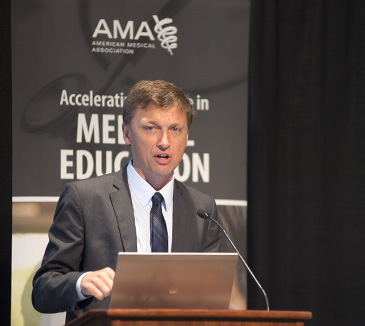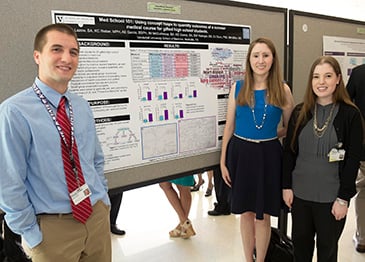How will physicians practice medicine in 2050—and how can medical schools train today’s students to be prepared? Physician educators tackled this question earlier this week during a special consortium meeting at Vanderbilt University Medical School in Nashville, where the 11 medical school recipients of AMA grants discussed how the changes they’re making are preparing tomorrow’s physicians for the rapid changes to come.
“Whatever 2050 throws at you, you cannot just cope and survive,” said Martin Pusic, MD, PhD, director of the division of education quality and analytics at the Institute for Innovations in Medical Education and assistant professor in the department of emergency medicine at New York University School of Medicine. “You must in fact become the physician 2050 needs and get better and better—not just survive but thrive.”
All 11 schools participating in the AMA’s Accelerating Change in Medical Education initiative are working through new ways to train students. Some of these approaches include:
- Switching from time-based to competency-based progression and assessments
- Implementing electronic portfolios that give students and educators real-time feedback and follow students through their careers
- Developing tools to analyze big data and better understand health populations
At the heart of all these changes is teaching students how to be skilled learners. With so much data and rapidly changing information, it’s critical for students to learn how to identify and weed out the information they don’t need while also investigating and implementing the information they do need. And the consortium schools are discovering that achieving this aim of training “master adaptive learners” isn’t easy.
“We are trapped in a knowledge dilemma,” said Mark Quirk, EdD, professor in the department of family medicine and community health at the University of Massachusetts Medical School.
“We have to introduce new competencies to address the needs of the new physician,” Quirk said. “[Today’s] clinical reasoning is taught by apprenticeship—pattern recognition with little reflection. The primary excuse is that we have insufficient time … but time is always going to be a factor.”
The goal is to train students to move into the next phases of their careers with a set of self-regulated, self-directed learning skills. That way, tomorrow’s physicians will be equipped to adapt and thrive in the constantly changing health care environment.
Students also recognize that skills in “learning how to learn” are necessary.
“We have to learn to navigate all the electronic resources at our fingertips … and we have to be knowledgeable about the false information out there,” said Katie Guess, a fourth-year medical student at Vanderbilt. “‘Dr. Google’ is going to be playing a role, and we have to manage that.”
Brian Heiniger, also a fourth-year medical student at Vanderbilt, echoed Guess’ thoughts.
“There are so many resources available, and so much information, that it is easy to get bogged down,” Heiniger said. “We need to know where and how to access information and to use it efficiently.”
The consortium of schools, now a full year into implementing new programs and tools, spent time outlining its goals through 2015. In the coming year, the group, facilitated by the AMA, hopes to increase activation and adoption of some of the innovations it has spawned, potentially bringing other schools on board and disseminating ideas for wider use.
“Curriculum change is not just schedule change. That would actually be very easy,” said Bonnie Miller, MD, senior associate dean for health sciences education and associate vice-chancellor for health affairs at Vanderbilt. “What we’re really talking about is culture change, and culture change of this magnitude is very difficult. We can’t do it alone.”
Watch AMA Wire® for additional coverage of the consortium meeting and updates about the work of the 11 medical schools.





